Mechanical advantage is a measure of the force amplification achieved by using a tool, mechanical device or machine system. The device trades off input forces against movement to obtain a desired amplification in the output force. The model for this is the law of the lever. Machine components designed to manage forces and movement in this way are called mechanisms. An ideal mechanism transmits power without adding to or subtracting from it. This means the ideal machine does not include a power source, is frictionless, and is constructed from rigid bodies that do not deflect or wear. The performance of a real system relative to this ideal is expressed in terms of efficiency factors that take into account departures from the ideal.

A pulley is a wheel on an axle or shaft enabling a taut cable or belt passing over the wheel to move and change direction, or transfer power between itself and a shaft. A sheave or pulley wheel is a pulley using an axle supported by a frame or shell (block) to guide a cable or exert force.
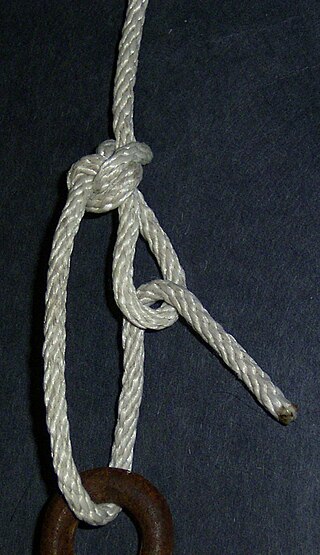
The trucker's hitch is a compound knot commonly used for securing loads on trucks or trailers. The general arrangement, using loops and turns in the rope itself to form a crude block and tackle, has long been used to tension lines and is known by multiple names. Knot author Geoffrey Budworth claims the knot can be traced back to the days when carters and hawkers used horse-drawn conveyances to move their wares from place to place.
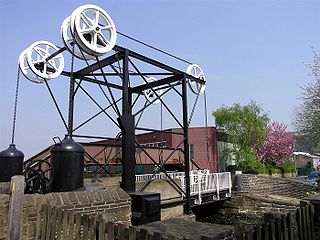
The windlass is an apparatus for moving heavy weights. Typically, a windlass consists of a horizontal cylinder (barrel), which is rotated by the turn of a crank or belt. A winch is affixed to one or both ends, and a cable or rope is wound around the winch, pulling a weight attached to the opposite end. The Greek scientist Archimedes was the inventor of the windlass. A surviving medieval windlass, dated to 1360-1400 is in the Church of St Mary and All Saints, Chesterfield. The oldest depiction of a windlass for raising water can be found in the Book of Agriculture published in 1313 by the Chinese official Wang Zhen of the Yuan Dynasty.

A mooring is any permanent structure to which a seaborne vessel may be secured. Examples include quays, wharfs, jetties, piers, anchor buoys, and mooring buoys. A ship is secured to a mooring to forestall free movement of the ship on the water. An anchor mooring fixes a vessel's position relative to a point on the bottom of a waterway without connecting the vessel to shore. As a verb, mooring refers to the act of attaching a vessel to a mooring.

A block and tackle or only tackle is a system of two or more pulleys with a rope or cable threaded between them, usually used to lift heavy loads.

A rope is a group of yarns, plies, fibres, or strands that are twisted or braided together into a larger and stronger form. Ropes have tensile strength and so can be used for dragging and lifting. Rope is thicker and stronger than similarly constructed cord, string, and twine.

In sailing, a sheet is a line used to control the movable corner(s) (clews) of a sail.

A derrick is a lifting device composed at minimum of one guyed mast, as in a gin pole, which may be articulated over a load by adjusting its guys. Most derricks have at least two components, either a guyed mast or self-supporting tower, and a boom hinged at its base to provide articulation, as in a stiffleg derrick. The most basic type of derrick is controlled by three or four lines connected to the top of the mast, which allow it to both move laterally and cant up and down. To lift a load, a separate line runs up and over the mast with a hook on its free end, as with a crane.

A belt is a loop of flexible material used to link two or more rotating shafts mechanically, most often parallel. Belts may be used as a source of motion, to transmit power efficiently or to track relative movement. Belts are looped over pulleys and may have a twist between the pulleys, and the shafts need not be parallel.
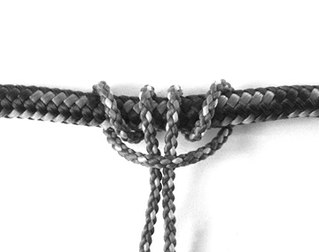
A Prusik is a friction hitch or knot used to attach a loop of cord around a rope, applied in climbing, canyoneering, mountaineering, caving, rope rescue, ziplining, and by arborists. The term Prusik is a name for both the loops of cord used to tie the hitch and the hitch itself, and the verb is "to prusik" or "prusiking". More casually, the term is used for any friction hitch or device that can grab a rope. Due to the pronunciation, the word is often misspelled Prussik, Prussick, or Prussic.

A fly system, or theatrical rigging system, is a system of ropes, pulleys, counterweights and related devices within a theater that enables a stage crew to fly (hoist) quickly, quietly and safely components such as curtains, lights, scenery, stage effects and, sometimes, people. Systems are typically designed to fly components between clear view of the audience and out of view, into the large space, the fly loft, above the stage.
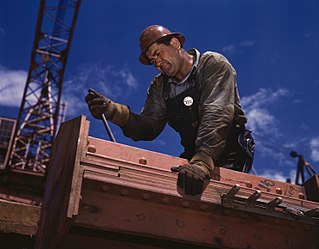
A rigger or slinger is a skilled tradesperson who specializes in the assistance of manual mechanical advantage device comprising pulley, block and tackle or motorised such as a crane or derrick or chain hoists or capstan winch.
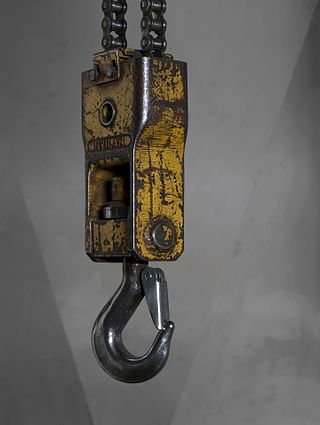
A lifting hook is a device for grabbing and lifting loads by means of a device such as a hoist or crane. A lifting hook is usually equipped with a safety latch to prevent the disengagement of the lifting wire rope sling, chain or rope to which the load is attached.

A Z-Drag or Z-Rig is an arrangement of lines and pulleys, effectively forming a block and tackle, that is commonly used in rescue situations. The basic arrangement results in pulling the hauling end 3 times the distance the load is moved, providing a theoretical mechanical advantage of three to one. In actual practice the advantage will be reduced by friction in the pulleys or carabiners. The advantage will also be reduced if the pull on the hauling end is not parallel to the direction the load moves in. The name comes from the fact that the arrangement of lines is roughly Z-shaped. Besides the mechanical advantage to pulling, it also uses only part of the total length of the rope for the block and tackle arrangement.
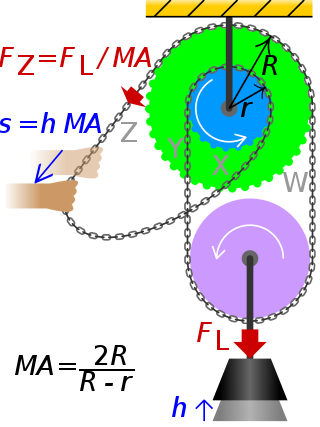
A differential pulley —also called "Weston differential pulley", sometimes "differential hoist", "chain hoist", or colloquially "chain fall"— is used to manually lift very heavy objects like car engines. It is operated by pulling upon the slack section of a continuous chain that wraps around two pulleys on a common shaft. The relative sizing of the two connected pulleys determines the maximum weight that can be lifted by hand. If the pulley radii are close enough, then the load will remain in place until the chain is pulled.
A drawworks is the primary hoisting machinery component of a rotary drilling rig. Its main function is to provide a means of raising and lowering the traveling block. The wire-rope drill line winds on the drawworks drum and over the crown block to the traveling block, allowing the drill string to be moved up and down as the drum turns. The segment of drill line from the drawworks to the crown block is called the "fast line". The drill line then enters the first sheave of the crown block and makes typically 6 to 12 passes between the crown block and traveling block pulleys for mechanical advantage. The line then exits the last sheave on the crown block and is fastened to a derrick leg on the other side of the rig floor. This section of drill line is called the "dead line."
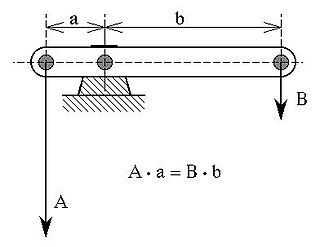
A simple machine that exhibits mechanical advantage is called a mechanical advantage device - e.g.:
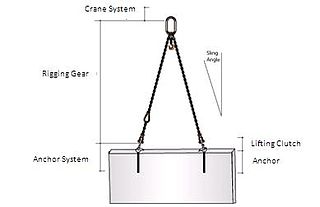
Rigging is both a noun, the equipment, and verb, the action of designing and installing the equipment, in the preparation to move objects. A team of riggers design and install the lifting or rolling equipment needed to raise, roll, slide or lift objects such as heavy machinery, structural components, building materials, or large-scale fixtures with a crane, hoist or block and tackle.
This glossary of nautical terms is an alphabetical listing of terms and expressions connected with ships, shipping, seamanship and navigation on water. Some remain current, while many date from the 17th to 19th centuries. The word nautical derives from the Latin nauticus, from Greek nautikos, from nautēs: "sailor", from naus: "ship".





















